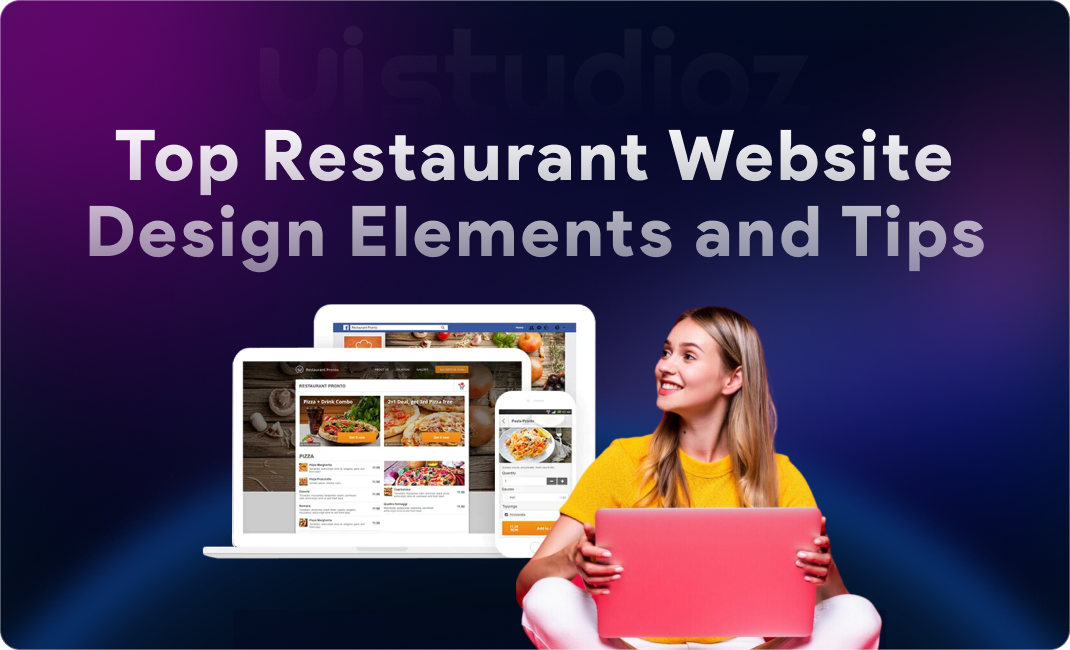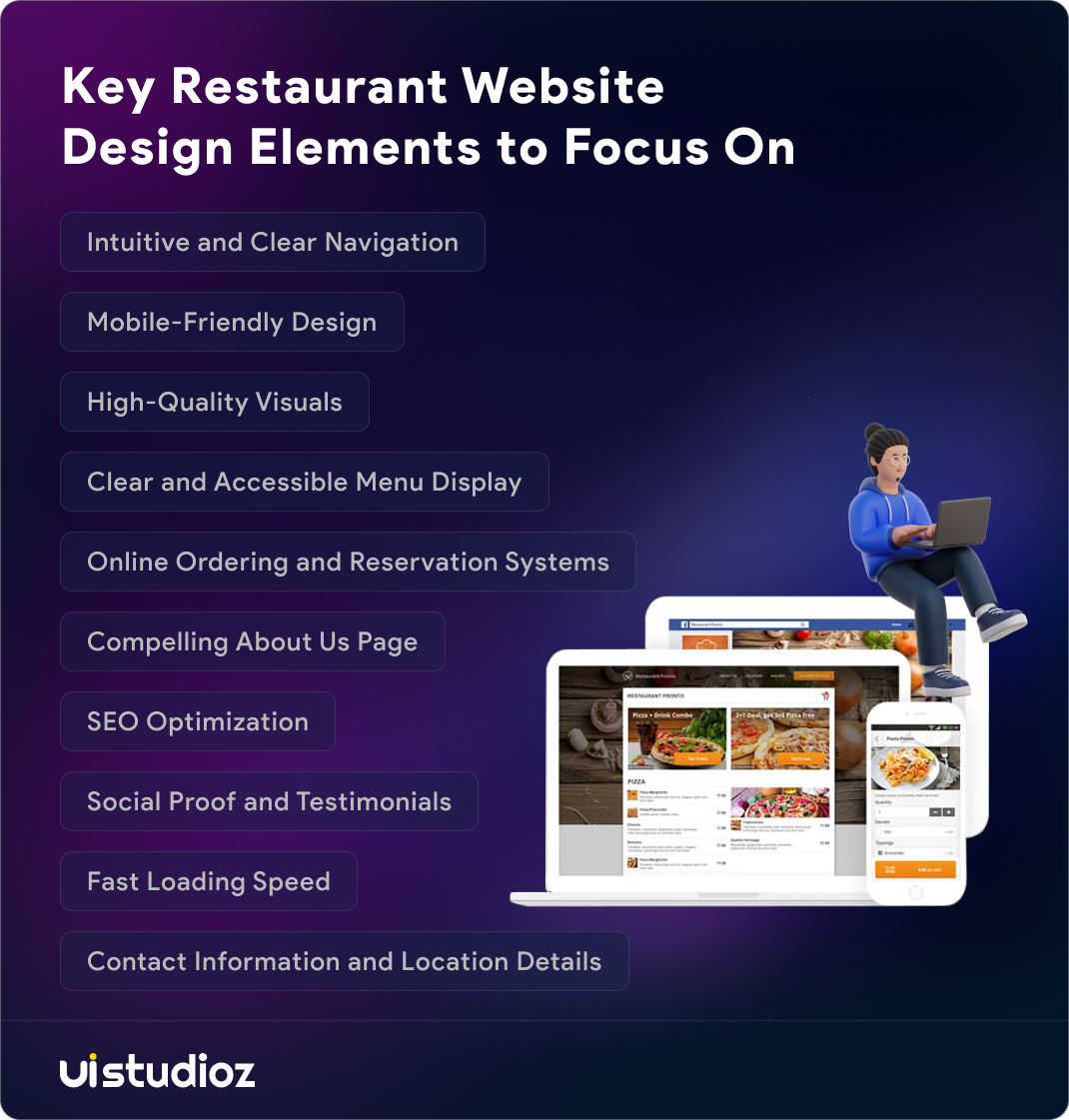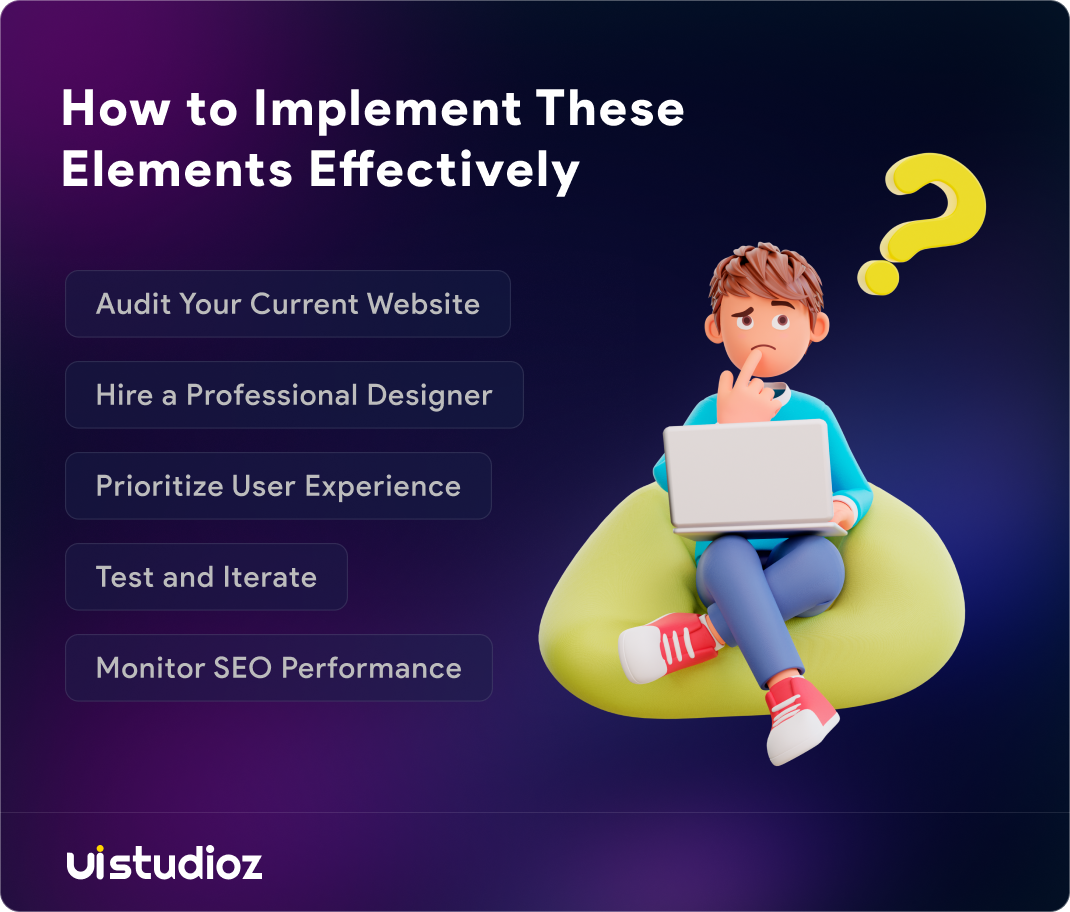Top Restaurant Website Design Elements and Tips

A restaurant’s website is often the first impression customers have of your business. If it’s slow, confusing, or outdated, potential diners may leave and choose a competitor instead.
Many restaurant websites fail because they overlook key design elements that improve usability and conversions. A poorly designed site can hurt reservations, online orders, and overall customer trust.
In this blog post, we’ll explore the essential restaurant website design elements that make a real difference. These best practices will help you create a site that’s attractive, functional, and focused on customer needs.
By the end, you’ll understand which design elements matter most and how to apply them to improve your restaurant’s online presence, gain more customers, and increase bookings.
Key Restaurant Website Design Elements to Focus On

1. Intuitive and Clear Navigation
Navigation is the backbone of any successful website, and restaurants are no exception. A well-structured menu bar helps visitors find what they’re looking for quickly—whether it’s your menu, location, or reservation system. Poor navigation can lead to high bounce rates, meaning visitors leave your site without taking action.
How to Get It Right:
- Keep your menu simple with clear categories like “Home,” “Menu,” “About,” “Reservations,” and “Contact.”
- Use descriptive labels. For example, instead of “Info,” use “About Us” to clearly convey the page’s purpose.
- Include a sticky navigation bar that stays visible as users scroll, making it easy to jump between sections.
A clean navigation system enhances the restaurant website user experience by guiding visitors effortlessly through your site. For instance, a fine-dining restaurant might prioritize showcasing its ambiance and chef’s story, while a casual eatery could highlight its takeout options. Tailor your navigation to reflect your restaurant’s unique offerings.
2. Mobile-Friendly Design
With over 60% of web traffic coming from mobile devices, a mobile-friendly restaurant website is non-negotiable. Customers often browse restaurant websites on their phones while on the go, looking for menus, directions, or reservation options. If your site isn’t optimized for mobile, you risk losing these potential diners.
How to Get It Right:
- Use responsive design to ensure your website adapts seamlessly to different screen sizes.
- Optimize images and videos to load quickly on mobile networks.
- Make buttons and links large enough for easy tapping with fingers.
- Test your site on multiple devices to ensure a smooth experience.
A mobile-optimized website not only improves user satisfaction but also boosts your restaurant website SEO. Google prioritizes mobile-friendly sites in search results, so this element is critical for ranking higher and attracting more visitors.
3. High-Quality Visuals
A picture is worth a thousand words, especially when it comes to food. High-quality images of your dishes, restaurant interior, and staff can entice visitors and give them a taste of what to expect. Visual design for restaurant websites is about creating an emotional connection with your audience.
How to Get It Right:
- Hire a professional photographer to capture vibrant, well-lit images of your food and ambiance.
- Use a consistent color palette that aligns with your brand identity.
- Avoid stock photos—they can make your site feel generic and inauthentic.
- Incorporate short videos, like a chef preparing a signature dish or a tour of your dining space, to engage users.
For example, a sushi restaurant might showcase close-up shots of beautifully plated rolls, while a cozy café could highlight its warm, inviting atmosphere. Great visuals make your website memorable and encourage visitors to book a table.
4. Clear and Accessible Menu Display
Your menu is the heart of your restaurant website. Customers visit your site to see what you offer, so make it easy for them to find and explore your menu. A poorly designed menu page—think tiny fonts or unreadable PDFs—can frustrate users and drive them away.
How to Get It Right:
- Display your menu in a clean, easy-to-read format with clear headings for categories like appetizers, mains, and desserts.
- Include prices, dietary information (e.g., gluten-free, vegan), and allergen warnings.
- Offer a downloadable PDF version for customers who prefer it, but prioritize an HTML-based menu for better SEO and accessibility.
- Update your menu regularly to reflect seasonal changes or new offerings.
A well-organized menu enhances the restaurant website user experience and builds trust with your audience. It also improves your chances of ranking for local searches like “Italian restaurant menu near me.”
5. Online Ordering and Reservation Systems
In 2025, convenience is king. Many customers prefer to order food online or book tables directly through your website. Integrating online ordering for restaurant websites and reservation systems can streamline operations and increase revenue.
How to Get It Right:
- Place prominent call-to-action (CTA) buttons like “Order Now” or “Book a Table” on your homepage and menu pages.
- Ensure the process is simple, with minimal steps to complete an order or reservation.
- Offer confirmation emails or texts to reassure customers their request was received.
For example, a busy pizzeria can increase takeout orders by offering a user-friendly online ordering system, while a high-end restaurant can reduce no-shows with an efficient reservation tool. These features cater to modern diners’ expectations and set your website apart.
6. Compelling About Us Page
Your “About Us” page is where you tell your restaurant’s story. It’s an opportunity to connect with customers on a personal level by sharing your mission, values, and what makes your restaurant special. A compelling story can turn casual visitors into loyal patrons.
How to Get It Right:
- Share your restaurant’s history, such as when it was founded and what inspired its creation.
- Highlight your team, like the chef’s background or the staff’s commitment to hospitality.
- Include photos or videos of your team in action to humanize your brand.
- Keep the tone authentic and relatable, avoiding overly corporate language.
For instance, a family-owned Mexican restaurant might share its generational recipes, while a trendy bistro could emphasize its commitment to sustainable ingredients. A strong “About Us” page builds trust and strengthens your brand identity.
7. SEO Optimization
A beautiful website is useless if no one can find it. Restaurant website SEO ensures your site ranks high on Google for relevant searches, like “best pizza in [city]” or “romantic dinner near me.” SEO involves both on-page and off-page strategies to boost visibility.
How to Get It Right:
- Conduct keyword research to identify terms your target audience uses, like restaurant website design tips or best restaurant website features.
- Optimize page titles, meta descriptions, and headings with relevant keywords.
- Create location-specific pages if you have multiple branches to target local searches.
- Build backlinks by partnering with local food bloggers or listing your site on directories like Yelp.
SEO is a long-term investment that drives organic traffic to your site. By incorporating keywords naturally and providing valuable content, you’ll attract more visitors and convert them into customers.
8. Social Proof and Testimonials
Customers trust other customers. Displaying reviews, testimonials, or media mentions on your website builds credibility and encourages new visitors to choose your restaurant. Social proof is a powerful tool for converting hesitant diners.
How to Get It Right:
- Showcase positive reviews from platforms like Google, Yelp, or TripAdvisor.
- Feature customer testimonials with their permission, ideally with names and photos for authenticity.
- Highlight awards, press features, or certifications, like “Best Burger in Town” or “Michelin Recommended.”
- Update your testimonials regularly to keep them fresh and relevant.
For example, a seafood restaurant could display a glowing review about its fresh oysters, while a vegan café might highlight a testimonial praising its plant-based desserts. Social proof reassures visitors they’re making the right choice.
9. Fast Loading Speed
A slow website frustrates users and hurts your SEO. Studies show that 40% of visitors abandon a site if it takes more than three seconds to load. Speed is a critical restaurant website design element that impacts both user experience and search rankings.
How to Get It Right:
- Compress images and videos to reduce file sizes without sacrificing quality.
- Use a reliable hosting provider with fast servers.
- Minimize the use of heavy plugins or scripts that slow down your site.
- Test your site’s speed using tools like Google PageSpeed Insights and address any issues.
A fast-loading website keeps visitors engaged and improves your chances of ranking higher on Google. It’s a simple yet effective way to enhance the overall user experience.
10. Contact Information and Location Details
Customers need to know how to reach you and where you’re located. Clear contact information and location details make it easy for them to get in touch or visit your restaurant. This element is often overlooked but essential for driving foot traffic.
How to Get It Right:
- Display your address, phone number, and email prominently on your homepage and contact page.
- Embed a Google Map to help customers find your location.
- Include your hours of operation and update them for holidays or special events.
- Offer a contact form for inquiries, ensuring it’s simple and functional.
For example, a downtown bistro might include parking tips alongside its address, while a suburban café could link to public transit options. Making this information accessible builds trust and encourages visits.
How to Implement These Elements Effectively

Now that you know the essential restaurant website design elements, it’s time to put them into action. Here’s a step-by-step plan to create or revamp your restaurant website:
- Audit Your Current Website: Identify what’s working and what needs improvement. Use tools like Google Analytics to track user behavior and pinpoint pain points.
- Hire a Professional Designer: Partner with a UI/UX design agency like Uistudioz to create a custom website tailored to your brand.
- Prioritize User Experience: Focus on intuitive navigation, mobile optimization, and fast loading speeds to keep visitors engaged.
- Test and Iterate: Launch your site and gather feedback from customers. Make adjustments based on their experience to ensure continuous improvement.
- Monitor SEO Performance: Track your rankings for target keywords like restaurant website design tips and adjust your content strategy as needed.
By following these steps, you’ll create a website that not only looks stunning but also drives measurable results for your restaurant.
Why Choose Uistudioz for Your Restaurant Website Design?
At Uistudioz, we specialize in crafting world-class UI-UX designs that elevate your digital presence. With over 11 years of global experience, we’ve worked with high-profile brands to deliver websites that are both beautiful and functional. Our team understands the unique needs of restaurant owners and can create a custom website that showcases your brand, engages customers, and boosts conversions.
Whether you need a mobile-friendly design, seamless online ordering, or SEO optimization, we’ve got you covered. Let us help you transform your restaurant’s online presence with a website that stands out in a crowded market.
Conclusion
A successful restaurant website is more than just a digital placeholder—it’s a powerful tool for attracting customers, building loyalty, and growing your business. By focusing on essential restaurant website design elements, such as intuitive navigation, mobile optimization, high-quality visuals, and SEO, you can create a site that delights users and drives results.
Don’t let a poorly designed website hold your restaurant back. Take action today by auditing your current site, investing in professional design, and prioritizing user experience. With the right approach, your website can become your most effective marketing asset, bringing hungry diners through your doors day after day.
Ready to elevate your restaurant’s online presence? Contact Uistudioz to start building a website that captures your brand’s essence and converts visitors into loyal customers.